Alba roses, or white roses (Alba)
Key features: hedges
Rose variety 'Alba Semiplena', History of origin: "" Interesting: Nikitsky Botanical Garden
Bourbon roses (Bourbon)
Main features: Large, open remontant shrub roses with long, bare or prickly shoots that can be climbing. Leaves are often shiny; the leaves are medium, oval. Flowers are numerous, fragrant, double or densely double, usually collected in bunches of 3; bloom in summer and autumn on short last year's shoots and shoots of this year. They are ideal for curbs, various types of supports, walls, pillars, columns. Examples: 'Louise Odier', 'Mme. Pierre Oger ’,‘ Zéphirine Drouhin ’(the latter is often presented as a climbing rose). Bourbon rose cultivar‘ Louise Odier ’, photo from buyarose.eu, Bourbon rose, drawing photo from wikipedia.org
Bourbon roses come from Ile Bourbon (now called Reunion) - a place off the coast of Madagascar in the Indian Ocean. It is believed to be the result of a cross between the 'Old Blush' fall damask and Chinese rose, which were often used as hedge material on the islands. They bloom profusely on vigorous, often semi-erect shrubs with shiny foliage and purplish colored shoots. They were first introduced in France in 1820 by Henri Antoine Jacques. Rose cultivar 'Nikolai Gartvis' from the group of climbing large-flowered
According to A.A. Galichenko (historian-researcher of Crimea), from 1827 to 1834 N.A. Gartvis created about 100 varieties of antique roses. He dedicated some of them to the Garden: ‘Belle de Nikita’, ‘Bouquet de Nikita’, others to outstanding people of his time: ‘Comtesse Pahlen’, ‘Princesse Anne Golitzyn’, ‘Baronne Yulie Berkheim’ and others.
Bourso roses, or Boursault roses (Boursault)
Main features: Climbing roses with long, arched, usually smooth shoots. Leaves are dark green; leaves of medium and large size, oval. Flowers are semi-double or double, slightly fragrant, single or collected in bunches of 3; bloom once at the beginning of summer on short last year's shoots. Used to decorate protected walls or supports. In central Russia, they require winter shelter. Examples: ‘Madame Sancy de Parabere’, ‘Inermis’, ‘Amadis’. Burso rose ‘Amadis’, photo from florum.fr; drawing, photo of the site fr.wikipedia.org History of origin:
These roses were created in France in 1829-1830. Presumably based on Rosa pendulina and R. chinensis. The group got its name in honor of the French breeder Jean-Francois Boursault.
Growing a wrinkled rose
Location: These plants are light-requiring. Preferred southern slopes or flat, sunny areas, protected from the prevailing winds.
Soil: require fertile, well-moistened soil, responsive to the introduction of mineral and organic fertilizers, mulching.
Planting: planted in spring before bud break or in autumn (preferably in spring). Plants are placed at a distance of 1.5 m from each other according to the scheme 3 x 1.5 m. When creating a high hedge, the planting density in the rows is 50-100 cm, between the rows 50-70 cm; medium-high - in the rows and between them - 10-60 cm. Before planting, apply organic and mineral fertilizers: 8-10 kg of humus or peat, 10 g of superphosphate, 50 g of potassium salt (per 1 m²). They are planted to a depth of 10-15 cm. After planting, abundant watering and mulching are recommended. The aerial part is cut off, leaving no more than 1/3 of the length of the shoots.
Usage: In single plantings, small groups, on the edges. One of the advantages of the best decorative forms of the river. wrinkled - a large bush, while thorny, thick branches do not need support. Decorative hedge from the river. wrinkled will protect the site from prying eyes and unexpected guests. At the end of September, the leaves of some forms of wrinkled roses acquire a very beautiful reddish color, and the bushes become a real decoration of the autumn garden.
In late summer and autumn, branches adorn not only flowers, but also fruits.Bright red or dark orange, they stand out effectively against the background of dense green foliage. Fruit weight varies from 7 to 10 g, diameter reaches 34 mm, length - 24 mm. From one bush, you can harvest from 2, 5 to 3, 6 kg. If the fruits are cleaned of seeds and hairs, then you can make aromatic, vitamin jam, jam, jam or compote from them. The flowers are also not only decorative, but also curative. From dried petals, you can brew healthy fragrant tea, and use the infusion to wipe your face instead of washing your face.
 Wrinkled rose bush. Putneypics
Wrinkled rose bush. Putneypics
The 4-year journey from disappointment to delight
This variety, like others, came to me according to the principle - I need to buy a white one, I don't have a white one. I pointed a finger - they gave me a seedling. I bought it at the market, the seedlings were from the nursery. I planted it on the edge of the flower garden and near (sorry) the trash can.
The first year the rose did not impress me at all! A low bush, not to be seen from behind the fence. The stems are somehow weak. The flowers are small. Hang. Moreover, most whites quickly lose their freshness. Damn what, and a bow on the side.
The second and third years did not significantly change the situation. The stems were hanging on the fence, the flowers were hanging down, the bush grew slightly and covered the trash bin. Thanks already.
Read about roses, about their varieties. Who would have bothered with that. However, I clearly saw that this was not a climbing rose, for we have one and it has powerful shoots, and at the previous place of residence there were already several of them. And this one is definitely not one of them.
This year, already the 4th in a row, the whips have climbed where it is not necessary. I don't know why my mother suddenly came up with the idea to tie a rose around a wooden post standing right there. The result is beyond expectations.
I saw and gasped!
Further photos, everything is clear without words!

Here is such a beauty, about 2 meters high. For comparison with the daughter in the foreground. Her height is 1.40.
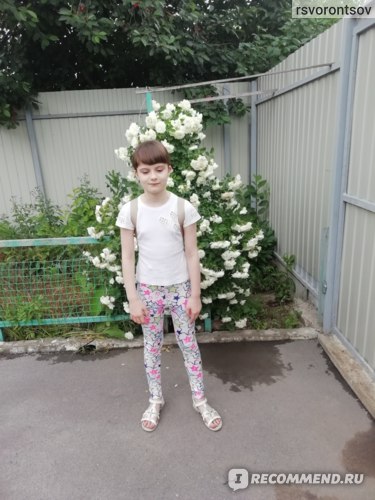
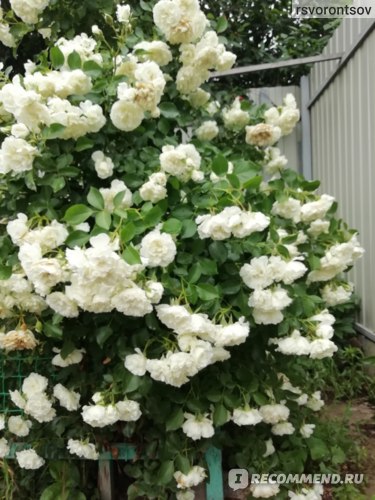
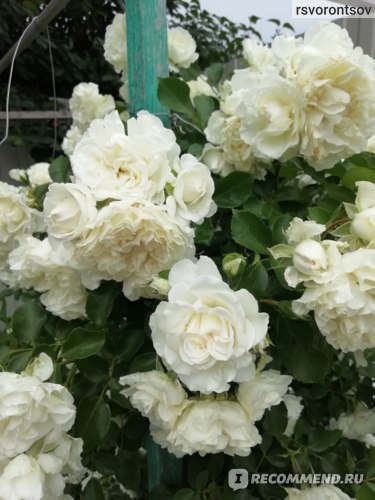
Next year I want to try to propagate and form a new bush in a slightly different way. Unless, of course, I stumble upon another ground cover rose for sale.
For myself, I noted a number of advantages of this variety.
- Due to the flexibility of the lashes, it can be formed as you like. Run along an alpine slide, form a hedge, tie it to a post, make an arch with roses. At least a ball!
- No need to cover for the winter. For 4 years she spent the winter on the outskirts of a flower bed, and at least that!
- In addition to aphids, no infection sticks to her
- Blooms extremely profusely from late May to October.
- An overgrown bush is a great place for a photo shoot.
- Calmly tolerates shade and partial shade.
Of the shortcomings, I note that after 5-7 days the flowers become sloppy and fall very slowly. However, they fall off themselves and do not have to be cut.
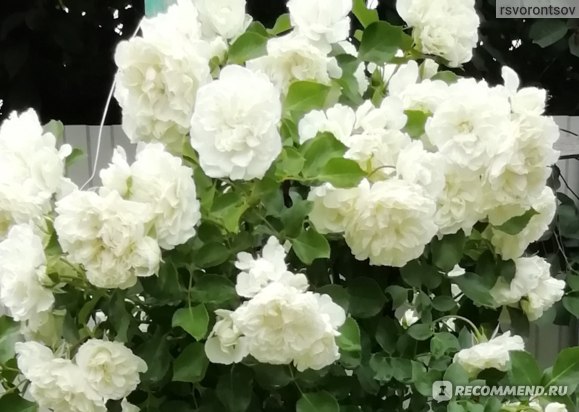
In general, if you need to organize an arch of roses over a bench in the garden, or put a rose on the trellises, or make a gazebo a "romantic corner" and at the same time you do not know anything about caring for roses at all - start with this variety. He will forgive you everything.
Laxa (Laxa, 2 varieties)

Specifications:
- wintering without snow -23С / snow more than 50 cm, -45С.,
- ACG 5 years, maximum 15 years,
- growth activity with soil warming up to - ND,
- seed germination with stratification 18 months, up to 40%,
- survival rate of eyepieces - ND,
- long root collar h10 cm.,
- there is a strong growth of eyepieces with many shoots,
- applies to most multi-flowered roses,
- good survival rate, moderate rooting rate 50 ... 60 days from the moment of planting,
- there is no growth activity.
Disadvantages:
- satisfactory wintering without shelter,
- unstable sap flow,
- susceptibility to diseases: rust, powdery mildew, black and purple spot,
- exactingness to pH 6.8 ... 7.0
Roses:
- standard growth of eyepieces,
- standard rose color,
- normal flowering (depending on the quality of the soil),
- standard number of inflorescences,
- maximum terry,
- standard flower size,
- there is no overgrowth,
- applies to all types of multi-flowered roses,
- good survival rate,
- normal safety during storage / shipment.
Disadvantages:
- the duration of care for transplanted plants,
- decrease in resistance to diseases in plants over 8 years old.
Varieties and description
Most known are those varieties that contain the surname Grothendorst in their name. This surname belonged to a Dutch gardener who managed to breed a large number of new types of wrinkled rose. However, there are also other varieties that have unique characteristics.
Queen of the North
Its advantages are resistance to frost, fungi and infections. It also grows and develops quite quickly. The height can reach two meters, and in the territory with a cold climate - about one meter. The flowering period is quite long - all summer and early autumn. Large double buds are colored deep pink, and sometimes white-pink. Its fruits are used to create tinctures, jams and compotes.

Rubra
The 2.5-meter wrinkled rubra rose is adorned with large pink flowers in summer. Subject to favorable weather and various positive factors, flower buds can bloom again during the season. At the end of summer, orange fruits are shown. The plant is appreciated for its unpretentiousness and easy maintenance. It can be used to decorate mixborders and hedges.

Grootendorst
In 1978, another hybrid was bred. Its flowers are arranged in groups of up to 10 pieces on one brush. A raspberry bud can be up to 4 centimeters in diameter. Its shape resembles a carnation. For this reason, the plant can also sometimes be called the clove rose.
Pink Grootendorst
The difference from the previous variety lies in the color of the buds - it is pink. The height of the shrub is one and a half meters. It is covered with wrinkled leaves of light green shades with a shiny coating and is decorated with 3 cm buds during the flowering period. Thanks to the lush flowering, the shrub looks presentable and can be used to decorate mixborders, hedges, as well as simply organizing group plantings.

Abelzieds
The 2.5-meter shrub is a type of Rubra variety. Cup-shaped pinkish flowers can reach 5-6 centimeters in diameter. The flowering is lush, but the aroma is weak.
Alba
White buds are densely located on the bush, but practically do not smell. The plant is prized for its frost resistance. Even in Siberia, the wrinkled alba rose will feel good. It can be used to decorate flower beds, hedges and other flower arrangements of various types.
Hansa
The appearance resembles the Alba variety, but the color of the buds is different - pale pink. It goes well with low-growing plants.
My Hammerberg
This variety is the lowest of all wrinkled roses - about 50 centimeters. Large leaves are painted with bright green colors, and 9-centimeter flowers are purple. The variety has a list of positive properties. For example, the aroma is quite strong, the frost resistance is high, and it does not need to be covered for the winter.

Step by step care instructions
- Choosing a landing site. The rose is planted in calm, sunny, preferably southern places.
- The soil should be fertile, loose and alkaline, which is achieved by adding rotted manure.
- Seed planting is carried out in March-April. The planting material is moistened and planted to a depth of 1-2 cm in seedling boxes. Seed germination begins in a week. When the seedlings reach a length of 10-12 cm, they are planted in open ground to a depth of 10-15 cm. There should be a distance of at least 1 m between the seedlings.
- Temperature. Rugosa grows at 18-34 degrees Celsius, the optimum temperature is 22-24 degrees.
- Watering is carried out at the rate of 10 liters per bush once every 2-3 weeks. During drought periods, the frequency of watering is increased.
- Top dressing is carried out in the spring with the help of mineral and organic agents:
- urea;
- peat;
- humus;
- Agricola-Aqua;
- "Roses";
- Pocona;
- Gloria.
- Pruning is carried out from the third year, in the fall, after harvesting the fruits.Lying branches and root shoots are subject to removal. Shoots are cut, leaving up to 20 well-developed branches. When they reach a height of 70 cm, their tops are pinched. In subsequent years, non-fruiting branches are removed and the crown is pruned.
- Transfer. Held from late August to September or spring. The inoculation site is harvested from the south side and fertilized with potassium agents. The shrub is dug up together with the ground so as to capture a section of roots 60 by 50 cm. As they are dug up, the roots are covered with burlap in parallel, after which the bush is removed and transferred to a new place. Sprinkle the roots with soil, which is tamped, and watered with the addition of top dressing.
- Preparing for winter. Activities include pruning stems up to 70 cm at a 45 degree angle, removing old branches and pinching off shoots. The shelter consists of three layers:
- sand (they cover the roots);
- dry peat (to keep warm);
- spruce branches (top layer).
Read about which varieties do not need shelter for the winter here.
Features of agricultural technology
The main advantage of China Girl is easy care. The main agrotechnical measures are aimed at preventing possible diseases, since the immunity of the variety to black spot and powdery mildew is slightly below average. Mandatory preventive measures:
If it is not possible to avoid infection, at the first sign of illness it is necessary to take urgent measures to combat the infection.
| Disease | Symptoms | Control measures |
| Infectious burn or stem cancer | Girdle brown spots with a reddish border, cracking of the stems with the formation of deep wounds | Cut the shoot to healthy tissue, followed by burning, treat the bush with copper sulfate |
| Rust | Typical rusty bumps on stems and foliage, orange-yellow spore clusters on the back of leaves | Spray the bush with the fungicide "Topaz", "Fitosporin-M", "Fundazol" or drugs of a similar action in conjunction with immunostimulants "Zircon", "Epin-extra" |
| Powdery mildew | Mealy grayish-white bloom on foliage and buds, leaf deformation | Treat with fungicides "Topaz", "Fundazol", "Saprol", remove and burn heavily affected areas |
| Black spot | Brown, gradually blackening rounded spots on the leaves, foliage falling, slowing the growth of shoots | Repeatedly spray the bush with fungicides, alternating the preparations "Profit", "Ridamil Gold", "Zircon", "Topaz", remove and burn the infected foliage |
Rose varieties for the Moscow region
The choice of roses for any area should take into account, first of all, its climatic features, since almost always the soil for roses is used imported with a sufficient amount of fertilizers. The Moscow region is a middle zone of a temperate climate, so the recommendations given here may apply to the entire middle zone or more southerly regions.
- The main requirement for such roses is susceptibility to cold weather.
- In this area, the established negative temperatures during the winter can reach -20 ° C.
- Twice in the last century, short-term drops to temperatures of -40 ° C were recorded, however, such frosts are abnormal for this territory.
- The number of sunny (clear and little cloudy) days in the season from April to September is 90.
- The total amount of natural precipitation over the same period is about 300 mm.
Based on these criteria, recommendations are made for growing various varieties of roses:
- Floribundas: Prince of Monaco, Mona Lisa, Rosenfi.
- Shrabs: Rhapsody Blue, Baroque, Camelot, Don Juan.
- Climbing: Amadeus, Jasmine, Westerland, Iceberg, Flamenz.
- Hybrid tea: Flamingo, Moscow Morning, Norita, Imperial, Dam de Ker.
- English and Austin: Shopshire Lad, Abraham Derby, Charles Darwin, Claire Austin.
- Old gardeners: Pierre Rosnar, Alba MaximaYu Artur Santal.
Also, many varieties of park and wrinkled roses are suitable for this climate (in fact, they are suitable for almost any climate) and some types of sprays, for example, Flash Fire.
Blooming roses
Rose: description of 16 varieties, features and care - such a different queen of flowers (150 Photos & Videos) + Reviews
9.4
Total Score
Description of varieties of roses
Relevance of information
9.5
Availability of application
9.5
Disclosure of the topic
8.5
Reliability of information
10
Alba Meidiland
Rose of the Alba Meillandecor variety - also called Meidiland - is also very unpretentious to care for. It was bred in 1987 and has won two American Rose Society (AARS) awards. It is distinguished by exceptional frost resistance, therefore it grows well both in warm, humid climates and in colder regions. The bushes are not tall, about 60-70 centimeters in height, and tend to grow in width, reaching 1.5-2 meters in diameter. Small and smooth leaves are usually dark green with a gray tint. Unlike Rugosa and Maxim, this variety does not bear fruit.
Note! This variety requires a lot of space, as it is prone to conquering territories. Consider this when landing.
Maidiland blooms from the second half of June until autumn and is very abundant. Terry flowers, small, 3-5 centimeters in diameter, collected in lush inflorescences of up to 7-10 flowers in each. They tolerate rain well and do not require pollination. At the end of the flowering period, they disappear by themselves, so there is no need to cut them off. They have a weak unobtrusive aroma.
Planting of this variety in temperate latitudes is usually carried out in spring, in April, in more southern areas - in autumn, in mid-October. Meidiland is not demanding on the soil, it can be planted almost everywhere where the acid-base level is in the range of 5-8 pH. The plant feels great both on the sunny side and in the shade. Great for grafting on a bole.
Additional Information! The stem for grafting must be dry to the touch and free of cracks, otherwise the plant will not take root.
Watering
This rose does not need increased watering, since it has a high drought resistance. It will be enough to water it weekly with settled water at the rate of one bucket per bush. In rainy periods, you can stop watering altogether. Meyandecor is not watered at the beginning of autumn to prepare it for wintering.
Good to know! Roses should not be watered late at night and during the day when the sun is at its peak. In the first case, night humidity and temperature changes can provoke the appearance of a fungus. In the second, through drops of moisture, acting on the principle of a lens, the plant can get sunburn.
Wintering
Since the Alba Meyandecor variety is not afraid of frosts, it is not necessary to cover it for the winter. However, this does not apply to standard roses.
Important! Roses on the trunk must be covered for the winter, otherwise they will die. To help such a rose overwinter without problems, the roots are gently undermined on one side
The stem is bent to the ground and fixed, tied to the support. In this case, a little free space should remain between the rose and the ground. Cover with spandex or spruce branches after the onset of stable frosts
To help such a rose overwinter without problems, the roots are gently undermined on one side. The stem is bent to the ground and fixed, tied to the support. In this case, a little free space should remain between the rose and the ground. Cover with spandex or spruce branches after the onset of stable frosts.
Pruning
In the spring, it is worth pruning the plant to get rid of frozen and broken stems. Madiland recovers very quickly after pruning, so you can thin out the bush without fear of damaging it. Despite the fact that this variety is very slightly susceptible to diseases, such as powdery mildew and black spot, it will not be superfluous to treat the plant with a 0.5% solution of copper sulfate for prevention.
Top dressing
Top dressing is usually carried out once immediately after removing the shelter and twice in the summer, during the budding period and a month and a half before the start of wintering. Fertilizer is applied in liquid form. Water the rose before and immediately after feeding.
Advantages and disadvantages
Pros of rose Alba Meyandecor:
- immune to diseases and fungi;
- perfectly tolerates cold;
- grows in almost any soil;
- recovers quickly after mechanical damage and trimming;
- suitable for grafting on a bole and creating a hedge;
- has beautiful neat flowers.
Cons of rose Alba Meyandecor:
- can capture the territory of other plants with abundant growth;
- prone to aphids;
- in some cases, dead flowers fall off too slowly.
This is a beautiful undemanding plant that is actively used both in landscape design and for decorating gardens in many countries. With proper care, it can delight the grower with its spectacular appearance for many years.
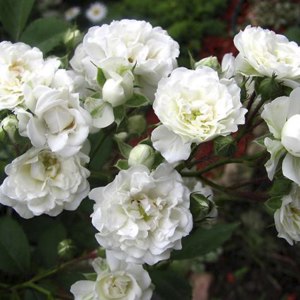
Features of planting roses
Since spring is late in Siberia, the soil often does not have time to warm up to a comfortable temperature for the roots, it is recommended to plant them on the southern side of the site. To prevent bud burnout, it is desirable that the plants are in the shade during the hours of the very activity of the sun.
The climate of Siberia is characterized by cold north and west winds. Therefore, the rosary must have protection from these directions. These can be walls of buildings, bushy plants, gazebos or hedges. So that the barrier from the wind does not greatly shade the roses, they are planted at some distance.
For the rose garden, if possible, elevated areas are selected. In such places, the soil does not have time to freeze to critical temperatures and quickly thaws. This means that the roots will develop faster in the spring, less risk of rotting due to excessive moisture.
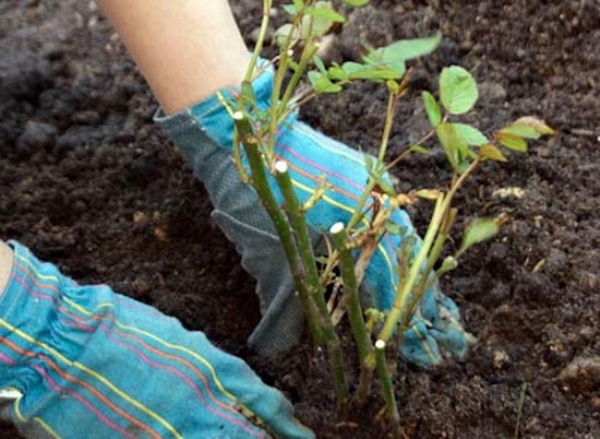 The planting season of roses in Siberia begins in May, when the soil warms up to 10 degrees.
The planting season of roses in Siberia begins in May, when the soil warms up to 10 degrees.
In Siberia, roses are recommended to be planted in spring. The event is planned from May 15 to June 15. In this case, the air temperature should not be lower than + 10 ° С. The shoots of plants planted later than these dates do not have time to ripen, which becomes the cause of death in the very first winter season.
The rest of the planting of roses in Siberia differs little from warmer regions. A planting pit (50x50x50x) is formed on a pre-dug area for plants and the substrate is prepared. To do this, mix the components on a piece of film:
- humus 3 parts;
- peat 2 parts;
- weathered clay 1 part;
- river sand 1 part;
- wood ash 400 g.
The minerals superphosphate 300 g and potassium sulfate 30 g are added to the soil mixture.
The roots of the seedling, longer than 20 cm, are cut and immersed in a growth stimulator for 3-4 hours. The rose is planted with a deepening of the grafting site: for climbing roses by 10 cm, and for spray roses by 7 cm.
During planting, a hill is formed at the bottom of the pit, on which a seedling is placed and the roots are spread. After dusting the roots and compacting the trunk circle, pour 10 liters of warm water. After that, the bush is spud to a height of 10-15 cm, the soil under the bush is mulched with peat or humus. At first after planting, the seedlings should be protected from direct sunlight.
Varieties
Alberic barbier
The variety appeared in 1890. The color of the flowers - from peach to white, changes over time. On one lash, from 1 to 3 large flowers 17 cm in size are formed. The aroma is medium-persistent. Plant height - about 500 cm, in width grows up to 400 cm. Resistance to diseases is average.
Paul transon
Shrub rose, bred in France in 1900. Differs in threefold flowering during the vegetative period. With each wave of flowering, subsequent flowers become smaller, with a fading color. The color of the petals is pink with a peach tint. On the stems, clusters of 6-10 buds with a rich aroma are formed. The flowering period is in mid-spring and autumn. Disease resistance is average.
Crimson Rambler
Bred in Japan in 1893, in different countries presented under different names. The bush grows up to 4 meters, in warm climates - up to 7 meters. The appearance of buds in early summer is considered a disadvantage.
Gerbe rose
The color of the petals is deep pink, red-pink or cherry-raspberry. The clusters are formed by 20 buds with almost no aroma. The size of the flowers is up to 5 cm. The shoots are long (on average, about 500 cm).Disease resistance is reduced.
"Lacorn"
A low-growing plant with large flowers located on a peduncle. During the period of falling petals, the peduncle droops. Pink colour. Fruits and pedicels are dotted with glandular bristles that produce sticky droplets. The foliage is dense, dark green.
Heritage
Flowers in pastel shades of pink. The plant grows up to 100-150 cm in height. Multiple flowering. With proper care, the bottom of the barrel is practically not exposed. Arcuate shoots with dense green foliage. The plant does not tolerate shade, needs full daylight.
Fantin-Latour
The name of the rose was first mentioned in the middle of the 20th century. The flowers are light pink with a transition to white. Long-flowering variety. The buds are collected in a brush of 5-10 pieces, the aroma is intense. The diameter of the flower is 9 cm. In height it reaches 170 cm, in width it grows up to 200 cm. Resistance to diseases is reduced.
Lemon Blush
Hybrid plant born in 1976. The flowers are yellow-peach, white at the edges. Long-lasting flowering. The plant belongs to semi-vine varieties.
Mme alfred carriere
The flowers are painted in light pink shades, close to white. 5 buds with a diameter of about 10 cm are formed on the stems. The aroma is rich, strong. Abundant flowering. Plant height - up to 500 cm, width - up to 300 cm. Resistance to diseases is average.
Maman Turbat
Polyanthus cultivar with flowers painted in pinkish shades, collected in a brush of several pieces. The plant is low, grows up to 70 cm, is resistant to frost and disease. Capable of continuous flowering.
Maria Liesa
The original rose is distinguished by small, simple flowers, collected in large clusters, reminiscent of a hydrangea. The color is bright pink. There is no aroma. The variety is undemanding to care. The height of the bush is about 300 cm, the width is 200 cm. Resistance to diseases and precipitation is increased.
Marie-jeanne
A low-growing plant, reaching a height of 80 cm. Flowers are double, small, collected in a brush up to 10 pieces. The buds are painted in a delicate pink-white shade, have a very light aroma. The bush is dense, especially decorative. Resistance to diseases and precipitation is average.
Rosa pendulina
The bush can be short (up to 90 cm), but with proper care it can reach 300 cm in height. The flowers are simple, five-petaled, 4 cm in diameter, painted in bright pink tones. The rose blooms once a year for several weeks. The fruit is a rose hip.
Rosalita
Fountain-shaped hybrid bush. Flowers are small, collected in a brush up to 10 pcs. The petals are colored in pale yellow and cream shades, the aroma is strong, musky. With age, the petals become white. The foliage is large, shiny, rounded, cinnamon greenish. Young leaves are bronze colored. The height of the shrub is up to 150 cm. Resistance to diseases and precipitation is increased.


